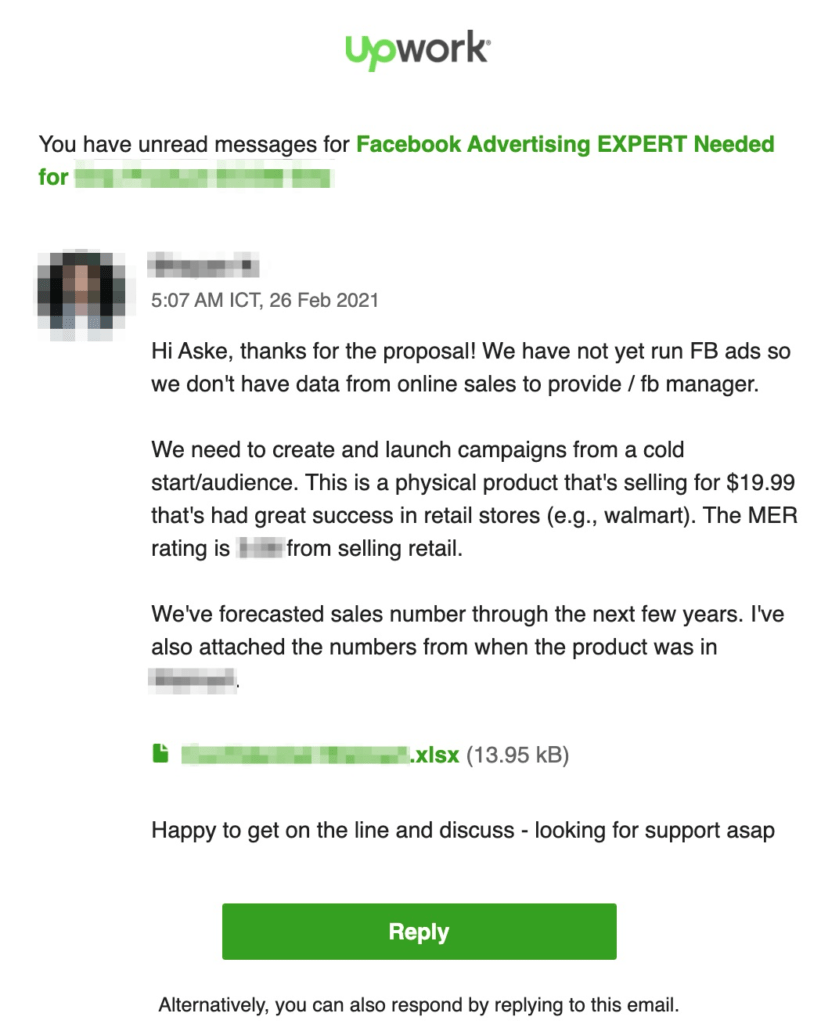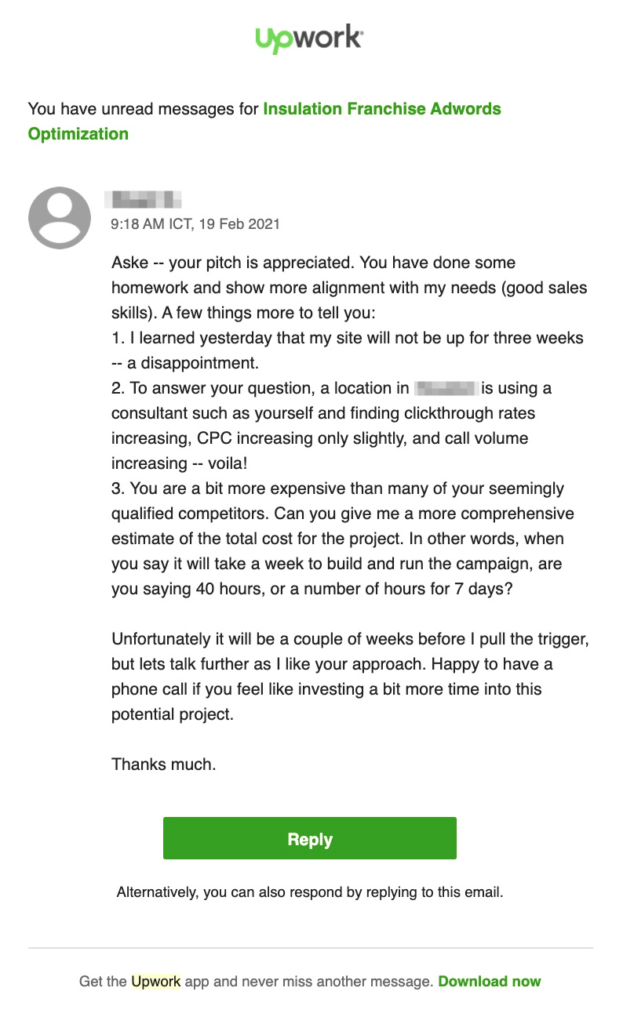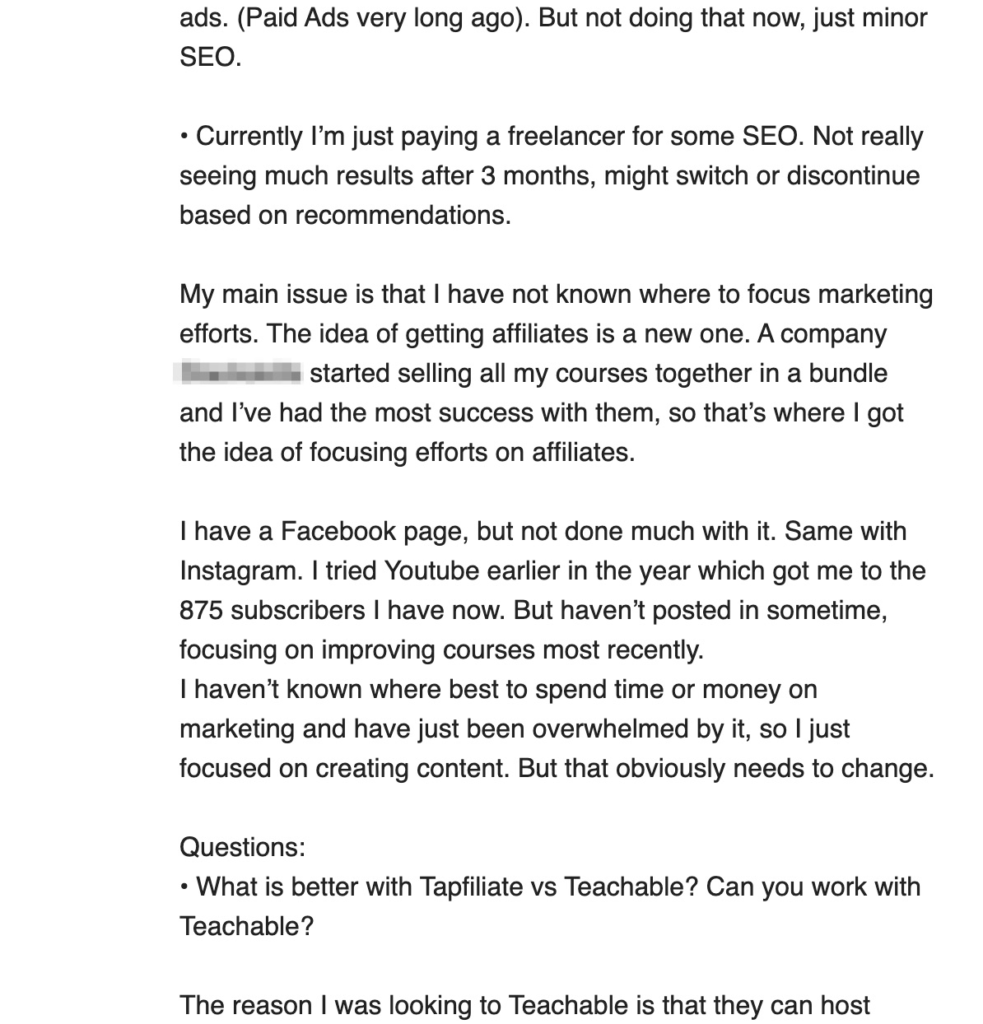In the search for the best cover letter for Upwork, allow me to share an example where I got a 100% response rate on my own proposals.



The last few weeks I’ve been comparing different styles of Upwork proposals, sending them out in the wild so you and I can better understand which one performs the best.
I see amazing case studies like these everywhere… but often there is something left out. Something that would kill the “shock factor”. Like when Derren Brown flipped a coin on its head ten times in a row:
The only way to guarantee that the coin lands on its head ten times in a row is to continue flipping the coin enough times until it happens by chance. However long that takes.
The same principle applies to our proposals because we can’t control how the client reacts. In order to get a 100% hit rate, we have to try until it happens by chance and then only show off that small sample of the experiment.
My example earlier is no different. What you didn’t see is the other thirty seven proposals I sent and the many times it didn’t work out.
The point is that it is okay to try again if things didn’t work out the first time. They rarely do and when we have to work a little for it first, it’s more fun when we do win.
Now, let’s dive into the whole experiment. I’ve tested different proposal styles, so you can see which type of Upwork proposal was best in the test and got the most client responses.
The four Upwork proposal styles
The theory of this experiment is that customized proposals will land more Upwork clients than generic copy-paste proposals. They have worked well in other experiments and now it’s time to put it to a test so we can get a side by side comparison backed with data.
The experiment
To find the service I wanted to offer, I looked at which type of keywords would have the most jobs for them based on my skill set. That would give me an indication of which keywords are more popular and which type of clients are more common. For example, clients with online courses compared to ecommerce businesses.
Below are some of the keywords I looked for. Keep in mind that just looking at the number of projects doesn’t say anything about the quality of the clients or projects but all other things being equal, the more projects available the more chance of landing a good one.
I searched within the digital marketing field since that’s my background and I looked across different client types, projects, skills, specific tools or anything else I could think of clients wanted help with.
For example, some clients will say that they need help with Facebook ads, while others say ads manager (the tool needed to run the ads). Some will say they need digital ads and I have to help them figure out if e.g. Facebook ads are the right fit.
Initially, I wanted to help online course creators with marketing automation since that seemed popular but after a few days with almost only shitty projects, I had to pivot to also bidding on projects related to Facebook ads or other similar looking projects.
The problem with Upwork and doing an experiment like this is that clients aren’t always good at explaining themselves. That means a project might appear good based on the description but when we speak with the client we might discover that it’s a waste of our time.
Anyway, I wanted to optimize my profile text before applying for jobs but ultimately I decided against it since there aren’t enough niche projects on Upwork that I could truly leverage the advantage of going niche.
I decided to keep it as is even though it isn’t entirely relevant and instead see how many people would actually look at my profile text.
It turns out no one did!
Anyway, I’ve outlined four proposal styles specifically for Upwork and in the experiment, I sent ten proposals using each of them so we can see which one works the best.
At a high level, the four Upwork proposals styles are:
1) Generic copy-paste proposals that are meant to fit most projects (meaning that they don’t fit any particularly well)
2) those that are (almost) custom written for each project but only talks about the freelancers’ experience, background, or a project recommendation
3) the one that focuses on the client’s challenges and what success looks like for each specific project along with why this freelancer is a good choice to solve the particular problem
4) the well-researched proposal. This one fits each project description well, focuses on client challenges, shares relevant background info as it relates to the project and is based on lots of research
Pricing
I was debating what to do about pricing for this experiment since it’s a factor that can have a large impact. Especially, because most clients I’ve come across on freelance websites like Upwork need help with hobby projects and thus don’t have much money to pay us freelancers.
With freelancing there are certain invisible pricing tiers where clients tend to expect something different for each one.
For example, when you cross a certain rate clients expect you to be good at communication beyond just the hard skills. There are no set tiers because it depends on each individual client but over time you will notice the difference if you raise your rates.
Another thought that crossed my mind is that if you are new to freelancing, charging $100/h can feel overwhelming. So I decided to charge $60/h during this experiment.
From experience, I’ve noticed that getting clients on a phone from the proposal is a more effective approach than trying to land the job directly with the proposal right then and there.
Since the phone call is different from the proposal, let’s focus on the writebacks from the proposals — how many potential clients respond to each proposal style. That way, we first get more clients to respond and then practice what to talk with them about after.
There’s something to be said about the quality but we can’t do anything to even that out and each job description is a judgment call based on the client’s description.
Of course, there are exceptions such as small, quick, projects. Those can often be hired without much extra discussion as long as everything about the project is clear in advance.
The best cover letter for Upwork: the winner
I waited about two weeks after sending the proposals to give clients a chance to either close their job or hire someone. I learned through other experiments that clients on Upwork tend to hire quickly, so this is a decent, balanced, timeframe.
Even so, for more than half of the projects there still hasn’t been any move forward as I’m writing this. As I checked again, I’ve noticed that in several cases it’s been a week or more since anyone looked at the project and they haven’t begun a conversation (“interviewing”) with any freelancer.

I’ve defaulted to categorize those projects as “no hire”-projects since clients more often than not don’t close their projects and just let them get auto-closed by Upwork after a month or so.
This will most likely be incorrect in the end since a couple of the clients probably will hire someone. But it doesn’t make sense for us to wait around since those few won’t make a meaningful difference in the data, the results and thus our reaction.
Before we jump into the results of each of the proposal styles, let’s first look at the total number of proposals and how we stack up against other freelancers altogether.
Remember, that the goal here was to get a writeback from the client. We can’t see the same data for other freelancers but we can if they were hired, that’s why I’m using that metric for other freelancers in the sheet below.
As we can see, the big deal here is that for more than 60% of the projects no freelance was hired. I noticed that on many of the projects, there would be more than 15 proposals and zero interviewees with more than a week since the client had last looked at the project.
That indicates the client might not be serious enough with the project, since they didn’t initiate contact with a single freelancer. We know that a similar proposal to what I sent gathers interest from other clients, meaning that the proposal can’t be that bad in all the cases.
While it might be tempting to get a competitive advantage against the other freelancers, it doesn’t make a meaningful difference. If you’ve been following the blog for a while, you’ll know that I focus on those few places where we can make a big impact because focusing on the minutiae won’t get us anywhere in life.
Instead, getting more clients to hire in the first place will be a bigger win for us, since that slice of the pie is 2x-3x bigger.
The results: the best cover letter for Upwork jobs
It’s time for the result of all the proposals! Here’s the data:
This category sucked.
This category was much better.
This category was not that good.
This category was even worse.
You probably don’t remember what each of the four proposal styles represents but you might have noticed that the results for three out of the four proposals are the same: 70%-80% of the projects never hired anyone as far as we can tell.
Pretty odd, right?
Sure, if we looked at a larger sample size, it might be different but what’s even odder is that proposal style two is upside down compared to the rest. I was interviewed 60% of the time while only one in ten jobs ended with no hire.
This is a surprise because on the surface this should be one of the worst proposal styles since it takes less time to create than the rest. But other freelancers got hired more in that category as well and that might indicate something with the clients rather than the proposals.
The caveat here is that the quality of the clients in this group might be lower than in the others depending on if we base it on the project description they wrote, earnings possible, business size, tasks they need help with, etc.
It’s hard to tell with the limited information we have access to on Upwork but I did have a few ideas as to what might have caused the difference:
- The client’s business size
- The proposal style
- The type of job description or job itself (e.g. automation vs Facebook ads)
- How my pricing was received
At first, I thought it was because all the job descriptions in that category had important details about the client and project even if they were short, meaning that the client might be more serious. For example, they shared what the product was and which industry it was in or what they needed help with specifically (you’d think that would be the minimum in all project descriptions… but not on Upwork).
As I compared them with the rest, I noticed that this was also the case for the other projects.
Next, I looked at the previous hiring rate to see if that might offer us a correlation. The average hiring rate was 51% for the clients that I pitched with the second proposal style and 52% for proposal style four, whereas the other two styles came out to 38% and 31% respectively. It brings us closer but doesn’t really give us a clear picture.
Another option is the type of clients. I tend to see two types on Upwork: the type who is looking for the best of the best and pay well (they usually choose the high-tier freelancers in the US as the clients tend to be from there as well).
And the type of client who is looking for more affordable help and is ok that they aren’t as skilled either in the hard skill and/or communication. I did see other freelancers being hired from both of those two categories.
The problem with evaluating the client quality is that unless we get specifics or speak with the clients it can be hard to tell how good of a fit they are for us.
A writeback itself doesn’t mean much since there can be more or less quality to it which is difficult to quantify and compare. There are even certain trigger words or sentences that can be used to get more writebacks but that doesn’t mean they will be worth much.
With the limited information we have from the clients, we might never know, so let’s move on to the winning proposal style and look at an example. If you have any theories or ideas, please leave a comment at the end of the article.
The winning proposal style is defined as those that are (almost) custom written for each project but only talks about the freelancers’ experience, background, or a project recommendation.
Examples:
The project description:
The proposal:
The writeback:
Another example:
The project description:
The proposal:
The writeback:
I expected the best cover letter for Upwork to be style three because it is a slightly upgraded version of style two without spending too much extra time and simply being better formatted and focused on the client rather than our experience.
But since, in this experiment, we can only look for the number of clients responding to our proposal, that is GREAT news! Proposal style two takes less time to create and it seems to work because it gives recommendations and an example right there in the initial proposal – something that helps build trust with the client.
When we use this style, we can use proposal templates to be more efficient but they take some time to create the first time. But it is worth it because we can reuse them.
A writeback example
I did get several writebacks showing interest but not being able to afford my rates. I was hesitant to bring this up since there are plenty of articles out there hating on Upwork.
Here’s a writeback example:





This is not always the case when we look for the best cover letter for Upwork. The challenge is sorting the right projects from the wrong ones because Upwork attracts smaller clients with a lack of resources.
This tends to be more important with marketing-related work than other services since marketing doesn’t have much effect if the product isn’t a good fit for the customers already. In comparison, any business at any stage might need help with things like admin work or graphic design.
That’s why I tend to recommend Upwork to professionals wanting to begin to earn money on the side. It’s a great way to get started if you have an approved account but we tend to get frustrated with the platform as we want to earn more beyond the first few thousand dollars.
I could have mentioned more about my pricing and how it’s a placeholder since some clients don’t want to engage because they know that they can’t afford it. That might have helped mitigate that concern.



Hello Chris, I have been a good follower of yours for a while. You always drop golden nuggets. I am really excited about this test. It has given me more insights on proposal, and I am very sure others will see benefits too. Thank you very much.
Thank you for saying that King!
Thanks Chris for this. I am Matt! Can I get in touch so I can learn from you. Hope you don’t mind me having your email address.
Great work done with the clear description of your experience by having logical thinking. Thank You for sharing this article. Much appreciated!
Amazing ????